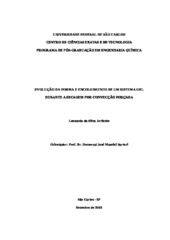| dc.contributor.author | Arrieche, Leonardo da Silva | |
| dc.date.accessioned | 2016-06-02T19:56:42Z | |
| dc.date.available | 2005-01-04 | |
| dc.date.available | 2016-06-02T19:56:42Z | |
| dc.date.issued | 2003-09-05 | |
| dc.identifier.citation | ARRIECHE, Leonardo da Silva. Evolução da forma e encolhimento de um sistema gel durante a secagem por convecção forçada.. 2003. 162 f. Dissertação (Mestrado em Ciências Exatas e da Terra) - Universidade Federal de São Carlos, São Carlos, 2003. | por |
| dc.identifier.uri | https://repositorio.ufscar.br/handle/ufscar/4066 | |
| dc.description.abstract | Knowledge of the shape evolution and shrinkage of a spherical gel system during drying by forced convection significantly enhances the understanding of this process under the vision of the transport phenomena. This work consists in the development of a gel system, with spherical geometry, which allows analyzing the effect of the fluid flow, in the boundary layer, on the moisture transport, shrinkage and on the shape evolution of the sample, during drying in an air stream forced convection equipment. The shrinkage was observed through the capture of images, used for the calculation of shape factors. The process was evaluated under a laminar flow (based on particle diameter), with a agar concentration of 1.5 and 3% (wet basis), fluid velocities varying from 1.0 to 2.0 m/s and initial particle diameters of 1.61.10-2 and 2.66.10-2 m, being the temperature maintained at 50 0C. The results confirmed with good reproducibility, proved statistically, that the circularity and specific mass of the samples decrease according to the formation of accentuated two-dimensional moisture profiles, for moisture contents lower than the critical value. The difference between the maximum and minimum diameters of a sample, during the process, evidenced the variation of the mass transfer rates between the previous and subsequent areas. It was inferred that during the constant drying rate period, the analysis is pondered in relation to the moisture transport, with the circularity and specific mass of the samples staying approximately constant. The gel system used allowed to reach the proposed objective, in a selective way, representing materials intensely affected by the shrinkage. | eng |
| dc.description.sponsorship | | |
| dc.format | application/pdf | por |
| dc.language | por | por |
| dc.publisher | Universidade Federal de São Carlos | por |
| dc.rights | Acesso Aberto | por |
| dc.subject | Secagem | por |
| dc.subject | Encolhimento | por |
| dc.subject | Fatores de forma | por |
| dc.subject | Períodos de secagem | por |
| dc.subject | Camada limite | por |
| dc.title | Evolução da forma e encolhimento de um sistema gel durante a secagem por convecção forçada | por |
| dc.type | Dissertação | por |
| dc.contributor.advisor1 | Sartori, Dermeval José Mazzini | |
| dc.contributor.advisor1Lattes | http://genos.cnpq.br:12010/dwlattes/owa/prc_imp_cv_int?f_cod=K4787341D7 | por |
| dc.description.resumo | O conhecimento da evolução de forma e encolhimento de um sistema gel esférico, durante a secagem por convecção forçada, significativamente aumenta a compreensão deste processo na visão dos fenômenos de transporte. Este trabalho consiste no desenvolvimento de um sistema gel, com geometria esférica, que permita analisar o efeito do escoamento na camada limite, entre o sólido e o fluido, no transporte de umidade, encolhimento e na evolução da forma da amostra, durante a secagem por convecção forçada. O encolhimento foi observado pela tomada de imagens, e os dados foram utilizados para o cálculo de fatores de forma. O processo foi avaliado sobre um escoamento de fluido laminar (baseado em diâmetro de partícula), com uma concentração de ágar de 1,5 e 3% (b.u.), velocidade do fluido variando de 1,0 a 2,0 m/s e diâmetros de partícula iniciais de 1,61.10-2 e 2,66.10-2 m, sendo a temperatura mantida em aproximadamente 50 0C. Os resultados confirmaram com boa reprodutibilidade, comprovada estatisticamente, que a circularidade e massa específica das amostras diminuem de acordo com a formação de perfis de umidade bidimensionais, para teores de umidade abaixo do valor crítico. A diferença entre os diâmetros máximo e mínimo de uma amostra, ao longo do processo, evidenciou a variação das taxas de transferência de massa entre as regiões anterior e posterior. Durante o período de taxa constante de secagem foi avaliado que a análise é concentrada, em relação ao transporte de umidade, com a circularidade e massa específica das amostras permanecendo aproximadamente constantes. O sistema gel desenvolvido permitiu alcançar o objetivo proposto de maneira seletiva, representando materiais intensamente afetados pelo fenômeno do encolhimento. | por |
| dc.publisher.country | BR | por |
| dc.publisher.initials | UFSCar | por |
| dc.publisher.program | Programa de Pós-Graduação em Engenharia Química - PPGEQ | por |
| dc.subject.cnpq | ENGENHARIAS::ENGENHARIA QUIMICA | por |
| dc.contributor.authorlattes | http://genos.cnpq.br:12010/dwlattes/owa/prc_imp_cv_int?f_cod=K4760973D2 | por |
